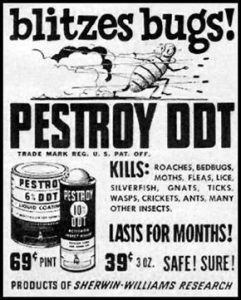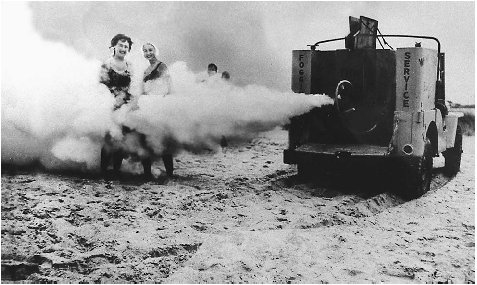We are obviously unhappy about all the spraying that’s been going on but have you ever wondered how we USED to combat the war on bugs?
In the 1940s, DDT was the first of the modern synthetic insecticides we used. While it was initially used to protect against malaria and typhus it was also effective against a variety of insects and therefore became a popular solution among U.S. farmers. But DDT use didn’t stop there, it was also was used in livestock production and sprayed on gardens, in institutions, and private homes.
Even migrant workers coming in from Mexico for seasonal farm work, under the Bracero Program, were sprayed thoroughly with DDT from 1942 to 1964. But attitudes about DDT changed in 1962 when the book, “Silent Spring”- which discussed the public concern about the dangers of pesticide use- was published.
It was eventually suspected as the culprit in the population decline of brown pelicans (due to a chemical deficiency, female pelicans egg shells were so thin most of them would break before embryos could mature) and was banned in 1972.
It is now considered a “possible human carcinogen” by the CDC. Possible. Ugh.
Malathion was registered for use in agriculture, gardens, and public recreation areas, in 1956 and is still widely used to combat mosquitoes. Normally it’s released from trucks or helicopters via an ultra-low volume spray that can stay in the air longer and which kills mosquitoes on contact.
From the article:
“In 1990, the Los Angeles County Department of Health Services began experiments on child volunteers (WHAT???), applying small amounts of malathion to their skin to test possible allergic responses in humans. The study was approved by a scientific panel from UCLA with the permission of the children’s parents (WHAT?????).
 When the urine analysis results were in, they found no traces of malathion in any of the 67 samples but samples from 12 children showed substances that form when malathion is metabolized in the body. So in 1991, a report based on those studied said that spraying malathion didn’t pose a serious threat to the “majority” of residents…unless it did and people got rashes, hives or had other allergic symptoms. Super. Oh, and the EPA warned people to not be in contact with high doses because it could overstimulate the nervous system, induce nausea, dizziness or confusion- but other than that- they were golden.
When the urine analysis results were in, they found no traces of malathion in any of the 67 samples but samples from 12 children showed substances that form when malathion is metabolized in the body. So in 1991, a report based on those studied said that spraying malathion didn’t pose a serious threat to the “majority” of residents…unless it did and people got rashes, hives or had other allergic symptoms. Super. Oh, and the EPA warned people to not be in contact with high doses because it could overstimulate the nervous system, induce nausea, dizziness or confusion- but other than that- they were golden.
Then in 1994 the pesticide was sprayed over 32,400 homes in LA County and from February to May about 250 residents reported skin rashes, allergic reactions, and other symptoms.
While we understand WHY pesticides are being sprayed- or at least why they think they should be spraying them- each of the pesticides listed above was originally thought safe and later proved not to be. When are we going to learn? WHEN?
Source: LA Times












